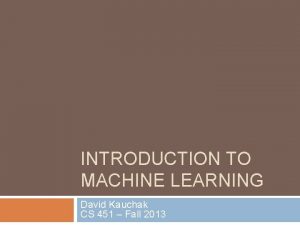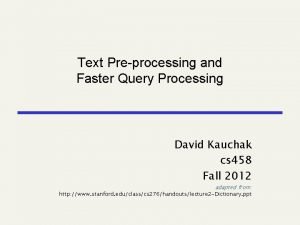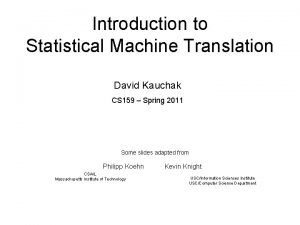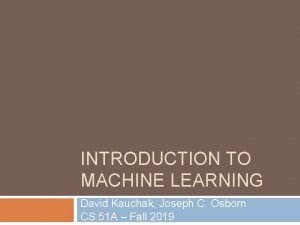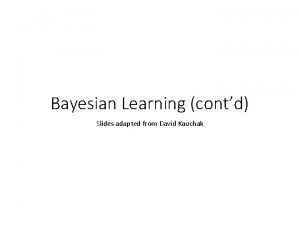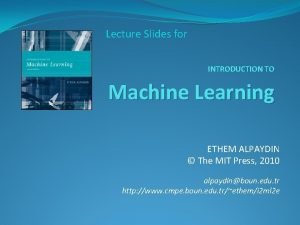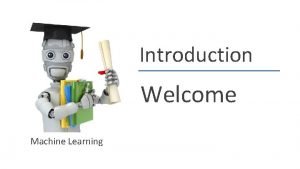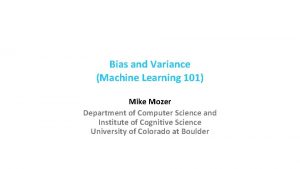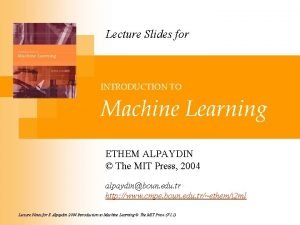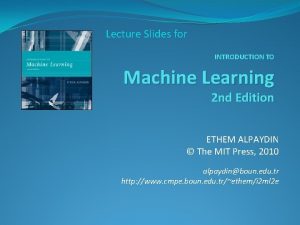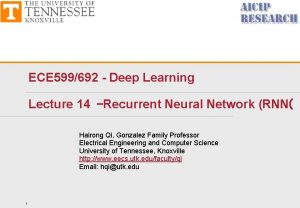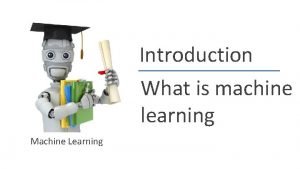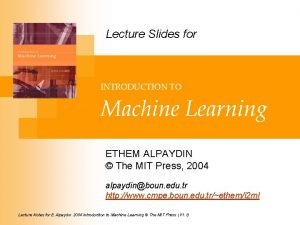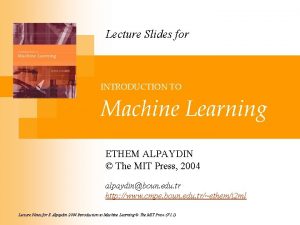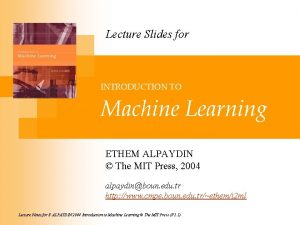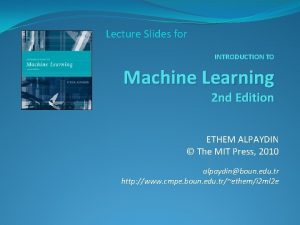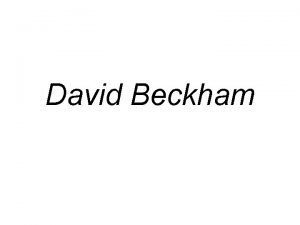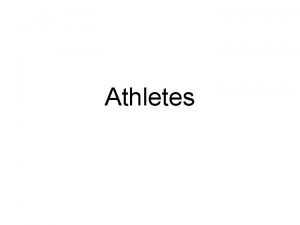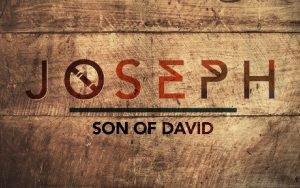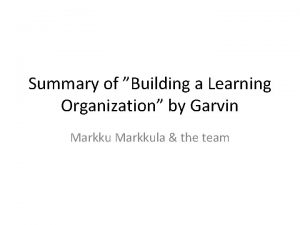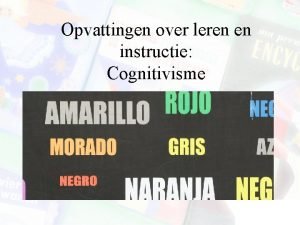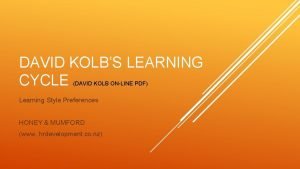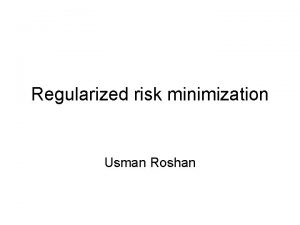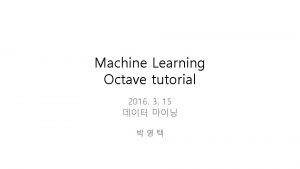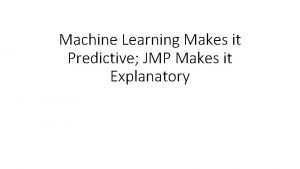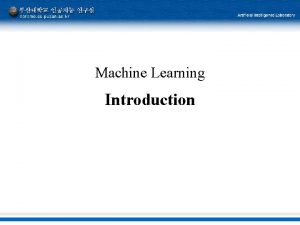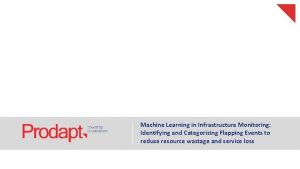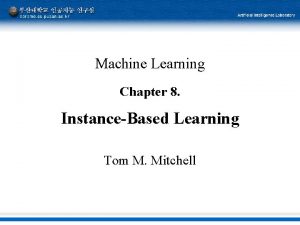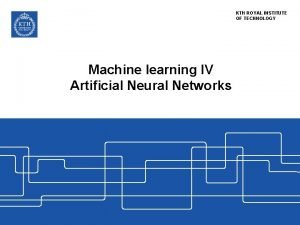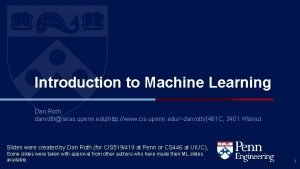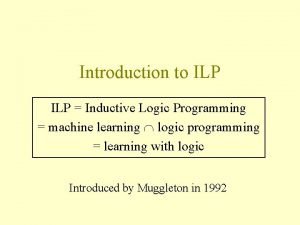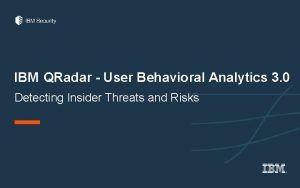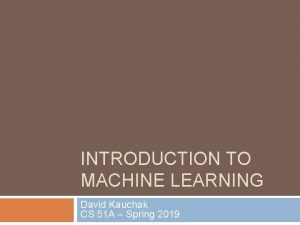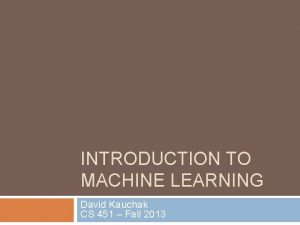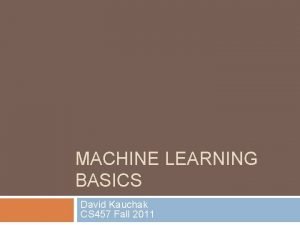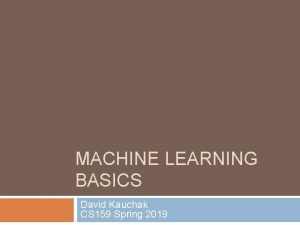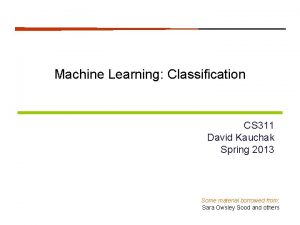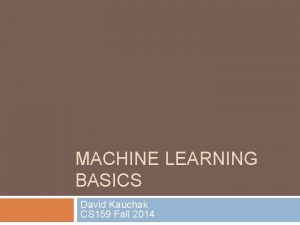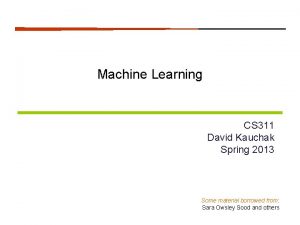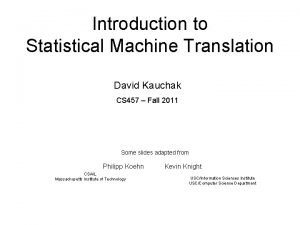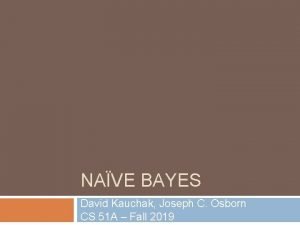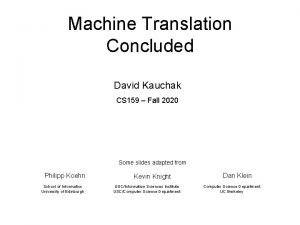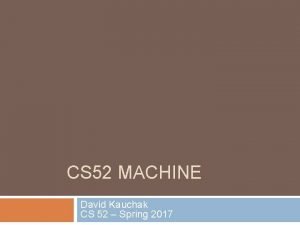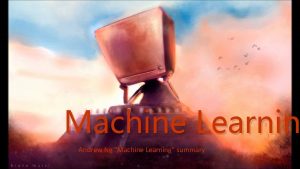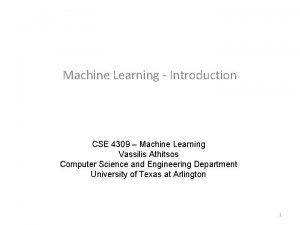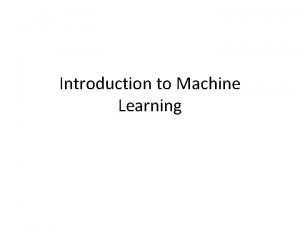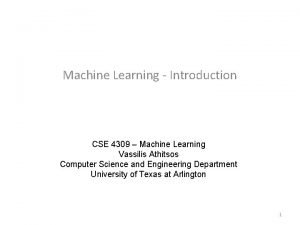INTRODUCTION TO MACHINE LEARNING David Kauchak Joseph C




























































- Slides: 60

INTRODUCTION TO MACHINE LEARNING David Kauchak, Joseph C. Osborn CS 51 A – Fall 2019

Machine Learning is… Machine learning is about predicting the future based on the past. -- Hal Daume III

Machine Learning is… Machine learning is about predicting the future based on the past. -- Hal Daume III past Training Data future n r lea model/ predictor Testing Data model/ predictor t c i d e pr

Data examples Data

Data examples Data

Data examples Data

Data examples Data

Supervised learning examples label 1 label 3 labeled examples label 4 label 5 Supervised learning: given labeled example

Supervised learning label 1 label 3 model/ predictor label 4 label 5 Supervised learning: given labeled example

Supervised learning model/ predictor predicted label Supervised learning: learn to predict new

Supervised learning: classification label apple Classification: a finite set of labels banana Supervised learning: given labeled example

Classification Example

Classification Applications Face recognition Character recognition Spam detection Medical diagnosis: From symptoms to illnesses Biometrics: Recognition/authentication using physical and/or behavioral characteristics: Face, iris, signature, etc

Supervised learning: regression label -4. 5 10. 1 Regression: label is realvalued 3. 2 4. 3 Supervised learning: given labeled example

Regression Example Price of a used car x : car attributes (e. g. mileage) y : price 15

Regression Applications Economics/Finance: predict the value of a stock Epidemiology Car/plane navigation: angle of the steering wheel, acceleration, … Temporal trends: weather over time

Supervised learning: ranking label 1 4 Ranking: label is a ranking 2 3 Supervised learning: given labeled example

Ranking example Given a query and a set of web pages, rank them according to relevance

Ranking Applications User preference, e. g. Netflix “My List” -- movie queue ranking i. Tunes flight search (search in general) reranking N-best output lists

Unsupervised learning Unupervised learning: given data, i. e. examples, but no labels

Unsupervised learning applications learn clusters/groups without any label customer segmentation (i. e. grouping) image compression bioinformatics: learn motifs

Reinforcement learning left, right, straight, left, left, straight, straight, left, right, straight, straight GOOD BAD 18. 5 -3 Given a sequence of examples/states and a reward after completing that sequence, learn to predict the action to take in for an individual example/state

Reinforcement learning example Backgammon … WIN! … LOSE! Given sequences of moves and whether or not the player won at the end, learn to make good moves

Other learning variations What data is available: Supervised, unsupervised, reinforcement learning semi-supervised, active learning, … How are we getting the data: online vs. offline learning Type of model: generative vs. discriminative parametric vs. non-parametric

Representing examples What is an example? How is it represented?

Features examples features f 1, f 2, f 3, …, fn How our algorithms actually “view” the data Features are the questions we can ask about the examples

Features examples features red, round, leaf, 3 oz, … green, round, no leaf, 4 oz, … How our algorithms actually “view” the data Features are the yellow, curved, no leaf, 8 oz, … questions we can ask about the examples green, curved, no leaf, 7 oz, …

Classification revisited examples red, round, leaf, 3 oz, … green, round, no leaf, 4 oz, … label apple n r lea model/ classifier yellow, curved, no leaf, 8 oz, … banana green, curved, no leaf, 7 oz, … banana During learning/training/induction, learn a model of what distinguishes apples and bananas based on the features

Classification revisited red, round, no leaf, 4 oz, … model/ classifier t c i ed r p Apple or banana? The model can then classify a new example based on the features

Classification revisited red, round, no leaf, 4 oz, … model/ classifier t c i ed r p Apple Why? The model can then classify a new example based on the features

Classification revisited Training data examples red, round, leaf, 3 oz, … green, round, no leaf, 4 oz, … Test set label apple yellow, curved, no leaf, 4 oz, … banana green, curved, no leaf, 5 oz, … banana red, round, no leaf, 4 oz, … ?

Classification revisited Training data examples red, round, leaf, 3 oz, … green, round, no leaf, 4 oz, … Test set label apple yellow, curved, no leaf, 4 oz, … banana green, curved, no leaf, 5 oz, … banana red, round, no leaf, 4 oz, … Learning is about generalizing from the training data ?

A simple machine learning example http: //www. mindreaderpro. appspot. com/

models model/ classifier We have many, many different options for the model They have different characteristics and perform differently (accuracy, speed, etc. )

Probabilistic modeling training data in a tr probabilisti c model: p(example) Model the data with a probabilistic model which tells us how likely a given data example is

Probabilistic models Example to label yellow, curved, no leaf, 6 oz probabilisti c model: p(example) features apple or banana

Probabilistic models For each label, ask for the probability yellow, curved, no leaf, 6 oz, banana yellow, curved, no leaf, 6 oz, apple features label probabilisti c model: p(example)

Probabilistic models Pick the label with the highest probability yellow, curved, no leaf, 6 oz, banana yellow, curved, no leaf, 6 oz, apple features label probabilisti c model: p(example) 0. 004 0. 00002

Probability basics A probability distribution gives the probabilities of all possible values of an event For example, say we flip a coin three times. We can define the probability of the number of time the coin came up heads. P(num heads) P(3) = ? P(2) = ? P(1) = ? P(0) = ?

Probability distributions What are the possible outcomes of three flips (hint, there are eight of them)? T T T H H H T T H H H

Probability distributions Assuming the coin is fair, what are our probabilities? probability = T T T H H H T T H H H number of times it happens total number of cases P(num heads) P(3) = ? P(2) = ? P(1) = ? P(0) = ?

Probability distributions Assuming the coin is fair, what are our probabilities? probability = T T T H H H T T H H H number of times it happens total number of cases P(num heads) P(3) = ? P(2) = ? P(1) = ? P(0) = ?

Probability distributions Assuming the coin is fair, what are our probabilities? probability = T T T H H H T T H H H number of times it happens total number of cases P(num heads) P(3) = 1/8 P(2) = ? P(1) = ? P(0) = ?

Probability distributions Assuming the coin is fair, what are our probabilities? probability = T T T H H H T T H H H number of times it happens total number of cases P(num heads) P(3) = 1/8 P(2) = ? P(1) = ? P(0) = ?

Probability distributions Assuming the coin is fair, what are our probabilities? probability = T T T H H H T T H H H number of times it happens total number of cases P(num heads) P(3) = 1/8 P(2) = 3/8 P(1) = ? P(0) = ?

Probability distributions Assuming the coin is fair, what are our probabilities? probability = T T T H H H T T H H H number of times it happens total number of cases P(num heads) P(3) = 1/8 P(2) = 3/8 P(1) = 3/8 P(0) = 1/8

Probability distribution A probability distribution assigns probability values to all possible values Probabilities are between 0 and 1, inclusive The sum of all probabilities in a distribution must be 1 P(num heads) P(3) = 1/8 P(2) = 3/8 P(1) = 3/8 P(0) = 1/8

Probability distribution A probability distribution assigns probability values to all possible values Probabilities are between 0 and 1, inclusive The sum of all probabilities in a distribution must be 1 P P P(3) = 1/2 P(3) = -1 P(2) = 1/2 P(2) = 2 P(1) = 1/2 P(1) = 0 P(0) = 1/2 P(0) = 0

Some example probability distributions probability of heads (distribution options: heads, tails) probability of passing class (distribution options: pass, fail) probability of rain today (distribution options: rain or no rain) probability of getting an ‘A’

Conditional probability distributions Sometimes we may know extra information about the world that may change our probability distribution P(X|Y) captures this (read “probability of X given Y”) Given some information (Y) what does our probability distribution look like Note that this is still just a normal probability distribution

Conditional probability example P(pass 51 a) P(pass) = 0. 9 P(not pass) = 0. 1 Unconditional probability distribution

Conditional probability example P(pass 51 a | don’t study) P(pass) = 0. 5 P(not pass) = 0. 5 P(pass 51 a) P(pass) = 0. 9 P(not pass) = 0. 1 P(pass 51 a | do study) P(pass) = 0. 95 P(not pass) = 0. 05 Conditional probability distributions Still probability distributions over passing 51 A

Conditional probability example P(rain in LA) P(rain) = 0. 05 P(no rain) = 0. 95 Unconditional probability distribution

Conditional probability example P(rain in LA| January ) P(rain) = 0. 2 P(no rain) = 0. 8 P(rain in LA) P(rain) = 0. 05 P(no rain) = 0. 95 P(rain in LA| not January ) P(pass) = 0. 03 P(not pass) = 0. 97 Conditional probability distributions Still probability distributions over passing rain in LA

Joint distribution Probability over two events: P(X, Y) Has probabilities for all possible combinations over the two events 51 Pass, Eng. Pass P(51 Pass, Eng. Pass) true, true . 88 true, false . 01 false, true . 04 false, false . 07

Joint distribution Still a probability distribution All questions/probabilities that we might want to ask about these two things can be calculated from the joing distribution 51 Pass, Eng. Pass P(51 Pass, Eng. Pass) true, true . 88 true, false . 01 false, true . 04 false, false . 07 What is P(51 pass = true)?

Joint distribution 51 Pass, Eng. Pass P(51 Pass, Eng. Pass) true, true . 88 true, false . 01 false, true . 04 false, false . 07 There are two ways that a person can pass 51: they can do it while passing or not passing English P(51 Pass=true) = P(true, true) + P(true, false) = 0. 89

Relationship between distributions joint distribution conditional distribution unconditional distribution Can think of it as describing the two events happening in two steps: The likelihood of X and Y happening: 1. How likely it is that Y happened? 2. Given that Y happened, how likely is it that X happened?

Relationship between distributions The probability of passing CS 51 and English is: 1. Probability of passing English * 2. Probability of passing CS 51 given that you passed English

Relationship between distributions The probability of passing CS 51 and English is: 1. Probability of passing CS 51 * 2. Probability of passing English given that you passed CS 51 Can also view it with the other event happening first
 Cs 451
Cs 451 David kauchak
David kauchak David kauchak
David kauchak David kauchak
David kauchak David kauchak
David kauchak David kauchak
David kauchak David kauchak
David kauchak Introduction to teaching kauchak
Introduction to teaching kauchak Concept learning task in machine learning
Concept learning task in machine learning Analytical learning in machine learning
Analytical learning in machine learning Pac learning model in machine learning
Pac learning model in machine learning Machine learning t mitchell
Machine learning t mitchell Inductive vs analytical learning
Inductive vs analytical learning Inductive and analytical learning
Inductive and analytical learning Instance based learning in machine learning
Instance based learning in machine learning Inductive learning machine learning
Inductive learning machine learning First order rule learning in machine learning
First order rule learning in machine learning Eager learning examples
Eager learning examples Cmu machine learning
Cmu machine learning Ethem alpaydin
Ethem alpaydin Andrew ng intro machine learning
Andrew ng intro machine learning Andrew ng introduction to machine learning
Andrew ng introduction to machine learning Mike mozer
Mike mozer Machine learning ethem
Machine learning ethem Machine learning introduction slides
Machine learning introduction slides Introduction to machine learning slides
Introduction to machine learning slides Introduction to machine learning and data mining
Introduction to machine learning and data mining A friendly introduction to machine learning
A friendly introduction to machine learning Introduction to machine learning andrew ng
Introduction to machine learning andrew ng Ethem alpaydin
Ethem alpaydin Introduction to machine learning ethem alpaydin
Introduction to machine learning ethem alpaydin Introduction to machine learning ethem
Introduction to machine learning ethem Machine learning lecture notes
Machine learning lecture notes Cuadro comparativo entre e-learning b-learning y m-learning
Cuadro comparativo entre e-learning b-learning y m-learning David beckham nickname
David beckham nickname David beckham 1985
David beckham 1985 Joseph son of david
Joseph son of david Finite state machine vending machine example
Finite state machine vending machine example Mealy or moore machine
Mealy or moore machine Moore machine
Moore machine Differentiate between simple machine and compound machine
Differentiate between simple machine and compound machine Building a learning organization by david a. garvin
Building a learning organization by david a. garvin Ausubel biography
Ausubel biography Cognitivisme
Cognitivisme Kolbs theory
Kolbs theory Bsp classification
Bsp classification Regularized risk minimization
Regularized risk minimization Sql server ml services
Sql server ml services Azure machine learning studio logo
Azure machine learning studio logo Octave machine learning
Octave machine learning Jmp machine learning
Jmp machine learning Tom m. mitchell machine learning
Tom m. mitchell machine learning Machine learning in infrastructure monitoring
Machine learning in infrastructure monitoring Machine learning actuary
Machine learning actuary Zillow data mining
Zillow data mining Tom mitchell machine learning solutions chapter 3
Tom mitchell machine learning solutions chapter 3 Hypothesis space in machine learning
Hypothesis space in machine learning Machine learning kth
Machine learning kth Hypothesis space in machine learning
Hypothesis space in machine learning Ilp machine learning
Ilp machine learning Qradar uba machine learning
Qradar uba machine learning
